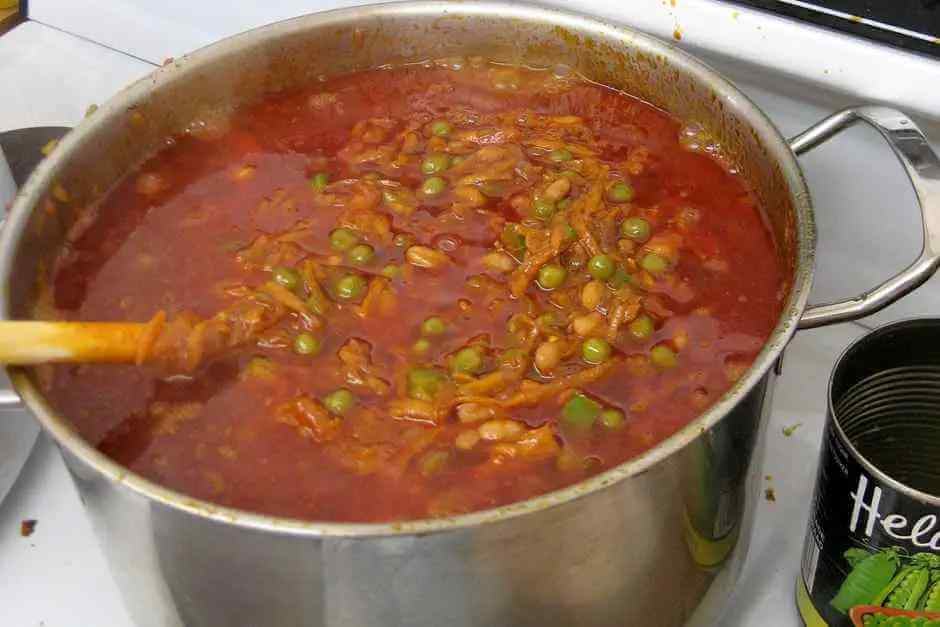Chakalaka recipe from South Africa
This Chakalaka recipe in its present form probably originated in the kitchens of the townships and mining settlements in and around Johannesburg South Africa. The court is in the South African cuisine It originated in the mid-1950s in the hostels where men lived in the townships. This is where miners who worked in the gold mines around Johannesburg lived. They mixed their ingredients together to make a vegetable stew. They served it with corn "pap," a porridge made from corn. This is also known as mielie pap. The workers in the hostels had little money, so there were no set ingredients for the dish. The recipe is therefore also a good way to use up leftovers.
History of the Chakalaka recipe from South Africa?
It is not known exactly where the name came from. Some say it comes from the Bantu language Setswana. Others say it means "quick and tasty". Others think it comes from the Zulu language and means something like "something that was hacked together". Still others claim it comes from Fanagalo, the language of the miners around Johannesburg. There are also versions that differ in spelling. One reads Chakka Lakka as well as Shakalaka. However, the name Chakalaka has spread internationally. I have also read about a Tschakka Lakka recipe. The Chakalaka dish definitely comes from the kitchens of the workers in the townships of South Africa. It's a type of vegetable stew traditionally served with barbecues and braais (barbecues) is served.
Is there an original Chakalaka recipe?
Nobody in particular invented it, it was created from a combination of different African cuisines and European influences. Ingredients vary by region and taste, but typical ingredients include onions, peppers, carrots, tomatoes, and beans. There are also spices such as cumin, paprika powder and ginger.
You often read about the original version of the Chakalaka recipe. However, this does not exist. The dish was created using whatever was available in the kitchen. Therefore, the preparation is varied. Depending on what the workers had available, they added onions, carrots, potatoes, peppers, cabbage, garlic, chili and curry powder. Ginger or coriander was also sometimes used. Originally, it was seasoned with whatever was available. Because curry was often used, some believe that Chakalaka was inspired by curry dishes from Asian cuisines. Some see the origin of the dish in the Indian-Malay region.
However, if the origin of the name from the Bantu language is correct, the Chakalaka recipe could also come from the kitchens of Botswana. A thick sauce made from tomatoes and onions is still made there today.
Where can you eat chakalaka in restaurants in South Africa
Chakalaka is usually served warm and goes perfectly with it grilled, but also with rice, bread or potatoes. In South Africa you can find it in almost every restaurant, but also in the markets and in the street stalls of the cities. Today the Chakalaka recipe is common as a sauce, soup or stew. In the shebeens, the pubs in the townships, it is often served as an ingredient with poultry, lamb, rice or corn porridge. It also tastes good with Boerewors, a type of sausage that is on the menu in many South African restaurants. Chakalaka is usually spicy. That's why they often add amasi, a kind of sour sour milk that's very popular in Africa. Chakalaka is a popular dish among locals and tourists alike.
Chakalaka is not as well known in Europe as it is in Africa, but there are a few restaurants and takeaways that have it on the menu. You can find it especially in big cities like London or Berlin, where there are many South African immigrants.
Insider tip: This is how I experienced Chakalaka in South Africa
During my travels through South Africa, I first tried chakalaka in a shebeen—unofficial pubs in the townships. There, the spicy vegetable dish was served alongside boerewors (a South African grilled sausage) and classic mielie pap—a thick corn porridge that wonderfully tempers the spicy flavor.
I was particularly impressed by the freshness of the ingredients and the combination of spiciness, sweetness, and texture. Since then, chakalaka has been one of my personal favorite recipes, whether cooked with mashed potatoes or in a Dutch oven while camping.
👉 My tip: If you really want to experience Chakalaka authentically, try it with boerewors or prepare it outside over the fire – this takes the taste to a whole new level!
This is how I like to cook the dish at home. Chakalaka, for example, can be cooked in a Dutch Oven in the Camping / Camper or on campfire prepare.
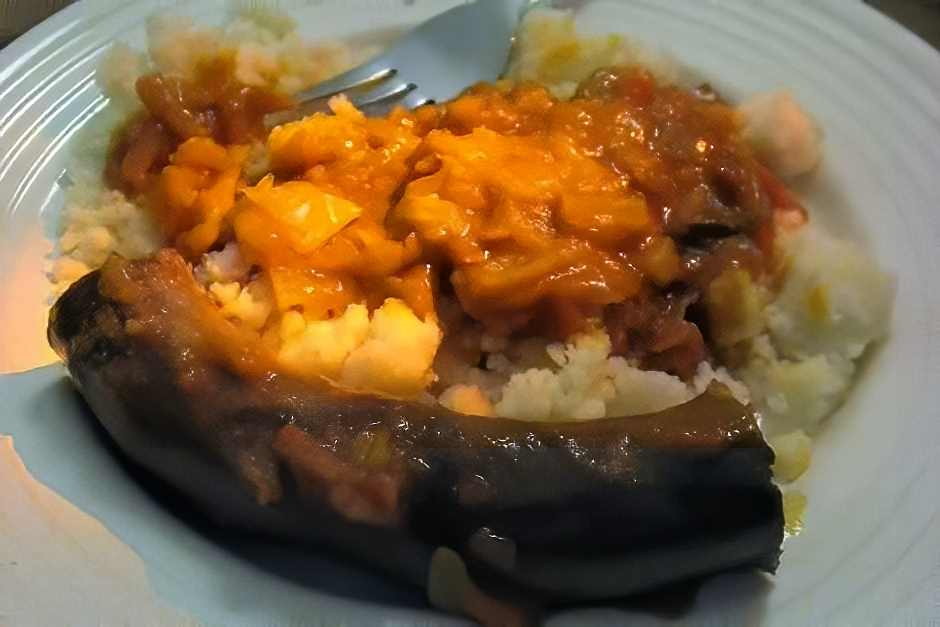
Preparing Chakalaka
Ingredients for our recipe for Chakalaka (8 servings)
- an onion
- a clove of garlic
- three carrots
- one red pepper and one each
- green pepper
- half a head of white cabbage
- six tablespoons of oil
- a tablespoon of salt
- five tablespoons of chakalaka spice
- 150 grams of green peas
- 400 grams of chunky tomatoes in a can
- 400 grams of white beans
- a tablespoon of sugar
- Salt at will
This spice set is particularly suitable for Chakalaka*
If you purchase via a link marked *, we receive a commission, which we use to run this blog.
How to cook the South African national dish
First, finely chop the onion and garlic.
Wash the vegetables and remove the cores from the peppers. Clean the carrots and cut the stalk from the white cabbage. Cut the vegetables into small cubes or thin strips.
Add half of the oil to the cabbage and salt it. Knead the cabbage well and then let it steep for a few minutes.
Put the oil in one pan and fry the chopped onions and garlic cloves in it.
Add the bell peppers and let everything simmer for ten minutes.
Add the Chakalaka spice and then stir the vegetables well.
Add the cabbage, carrots, and peas to the vegetable mixture. Add the diced tomatoes and the beans. Season with sugar and mix the vegetables well.
Let the vegetable mixture simmer for about 20 minutes and finally season with salt. If you want it to be particularly spicy, you can add some chili powder.
The Chakalaka recipe from South Africa is traditionally served with corn porridge. But it also goes well with rice or mashed potatoes, coarse sausages or poultry, lamb or ribs.
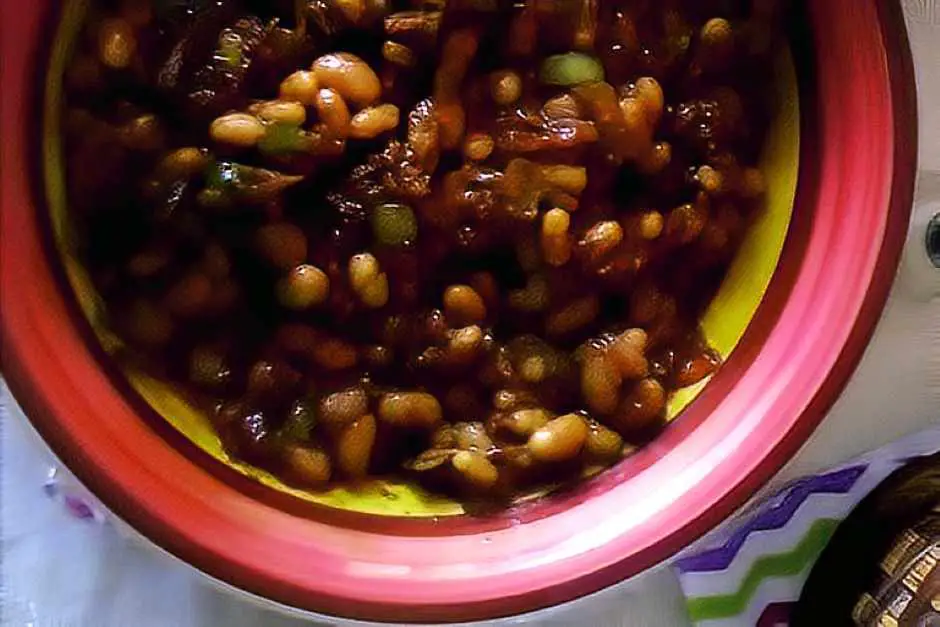
Chakalaka recipe from South Africa: Discover the variety of variations
Chakalaka is more than just a side dish. This spicy vegetable dish from South Africa has many faces. Whether as Dip, sauce or stew, Chakalaka is versatile and suits many occasions. Here you can find out how you can vary the recipe to suit your taste.
Classic Chakalaka
The basic recipe is simple. You need onions, garlic, peppers and tomatoes. There are also spices such as curry powder and chili flakes. Everything is fried in a pan and then braised briefly.
Chakalaka with beans
For a more filling option, add cooked beans. White beans or kidney beans work well. They make the dish more nutritious and give it a different texture.
Chakalaka with meat
If you like meat, you can too Sausage or add chicken. Fry the meat beforehand and then mix it with the vegetables. This way you get a complete meal.
Fruity Chakalaka
For a fruity touch, add pineapple or mango. The fruit gives the dish a sweet note and harmonizes well with the spiciness of the chilies.
Chakalaka with seafood
Fish and seafood lovers can add shrimp or squid. Be careful not to overcook the seafood to avoid it becoming tough.
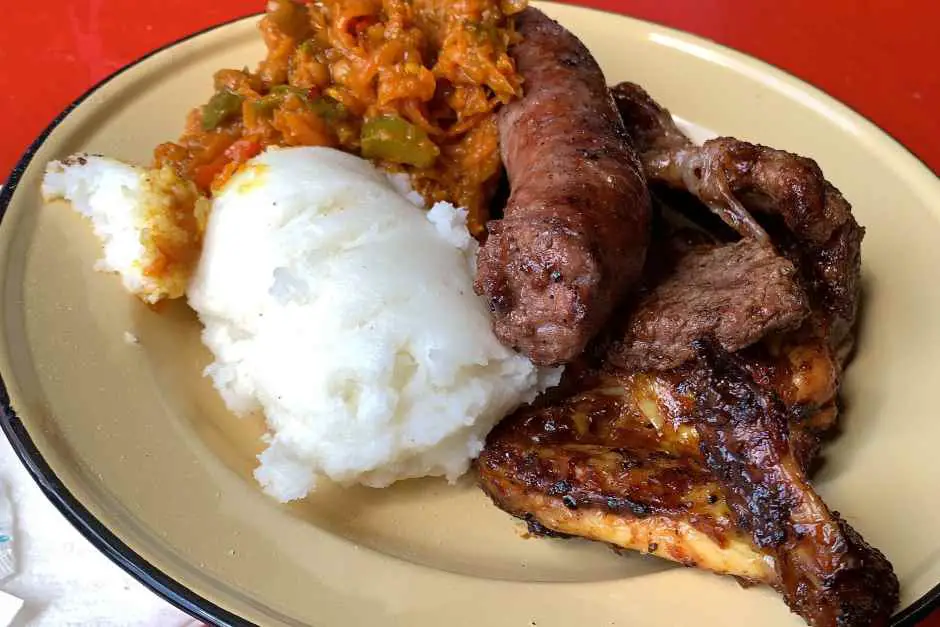
Spicy vegetable classic: The best side dishes for your meal
Chakalaka is a real classic in South Africa. This spicy vegetable dish is not only delicious, but also versatile. But which side dishes go best with it? Here are some ideas to complete your Chakalaka experience.
Rice: The all-rounder
Rice is probably the simplest and most popular side dish for Chakalaka. It absorbs the sauce well and tempers the spiciness of the dish. Basmati rice or jasmine rice are particularly suitable.
Cornbread: A South African must-have
In South Africa, chakalaka is often served with cornbread. The bread is slightly sweet and complements the spicy Chakalaka perfectly. You can buy it ready-made or bake it yourself.
Potatoes: Simple and delicious
Whether fried, boiled or pureed – potatoes always work. They are a good alternative if you don't like rice. Plus, they're quick to prepare and filling well.
Grilled meat: For meat lovers
Chakalaka and grilled meat are a dream couple. Whether chicken, beef or lamb, the spicy vegetables go well with everything. So if you Grill Chakalaka should not be missed.
Salad: For a light touch
A fresh salad brings variety to the plate. A simple green salad or a tomato salad go particularly well. They bring freshness and are a good contrast to the spiciness of the Chakalaka.
FAQ: Frequently asked questions about Chakalaka
1. What ingredients go into a Chakalaka?
Traditionally, chakalaka consists of simple yet aromatic ingredients such as onions, bell peppers, tomatoes, carrots, and beans. This base is refined with spices such as curry powder, garlic, ginger, chili powder, and sometimes cumin. Depending on the region or preference, white cabbage, peas, or potatoes may also be added. The dish thrives on its flexibility—originally, it was cooked using whatever was available.
2. Is Chakalaka always spicy?
No – although chakalaka is often spicy, the spiciness depends on the recipe. Many households use chili generously, but you can easily adjust the spiciness. If you prefer a milder dish, simply reduce the amount of chili or serve it with amasi (an African sour milk), yogurt, or crème fraîche. Tip: A little sugar or mango can balance the spiciness.
3. What goes well with Chakalaka?
Chakalaka is extremely versatile. In South Africa, it's often served with mielie pap (corn porridge) or boerewors (South African grilled sausage). It also goes well with rice, mashed potatoes, grilled meat, fish, or bread. For a vegan dish, you can also simply serve chakalaka with flatbread or couscous—filling and delicious!
4. Is there an original recipe for Chakalaka?
There's actually no fixed "original recipe." Chakalaka originated in the townships of South Africa as a creative dish made from leftovers and whatever was available. Therefore, there are many variations: with or without beans, with cabbage, sometimes fruitier, sometimes spicier. The aromatic base of vegetables and spices is particularly important. Every family often has its own recipe—that's what makes chakalaka so special.
5. Where does Chakalaka originally come from?
Chakalaka likely originated in the townships surrounding Johannesburg and was invented in miners' hostels. There, the men cooked a nutritious, spicy dish from simple ingredients – often over an open fire. The exact origin of the name is unclear, but it may come from Setswana, Zulu, or Fanagalo, a pidgin language spoken by the miners. Today, chakalaka is a true classic at South African braais (barbecues).
South African recipes
Further Recipes from South Africa here.
Sources:
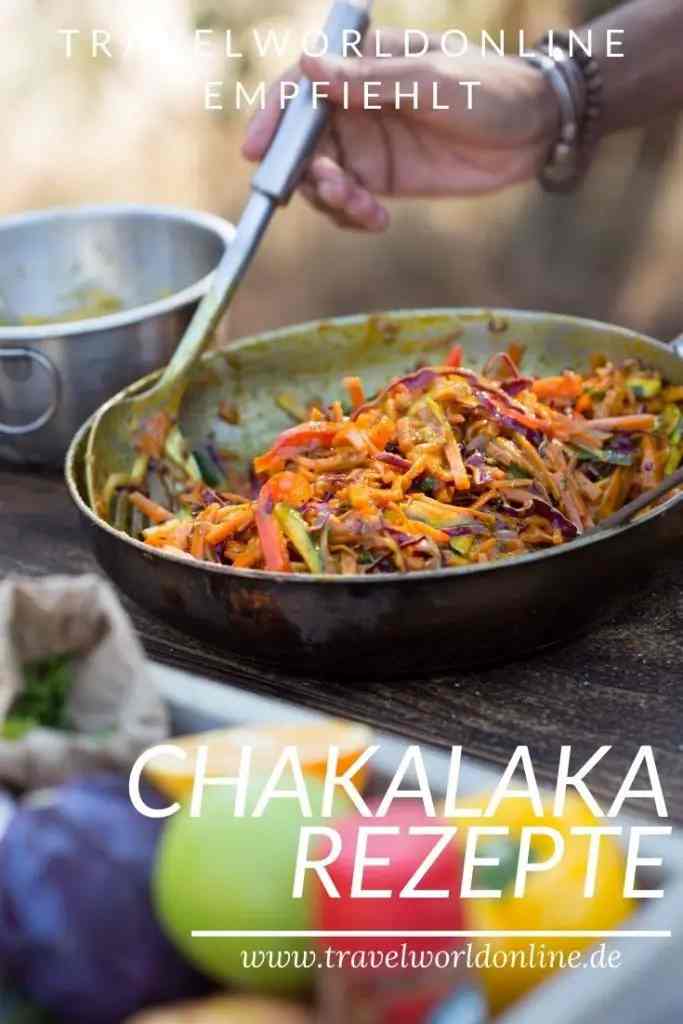
Do you know this?
- the best located wineries in South Africa
- Staying at a hotel in Cape Town
- Funky Africa in Salzburg
- Eating African
- Gas grill recipes
- Buy gas grill online
- Gas grill accessories - why is it worth it?
- Grill Spare Ribs with a Rib Marinade
- Potjiekos from South Africa
- Cool box for camping
- Bobotie recipe from the Cape region of South Africa
- Slow Travel Blog
Source Chakalaka recipe South Africa: own research on site. My opinions definitely remain my own.
Text Original Chakalaka Recipe: © Copyright Monika Fuchs and TravelWorldOnline
Photos Chakalaka recipe from South Africa: © see caption, Pixabay, Wikimedia Commons and Flickr Public Domain
